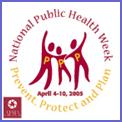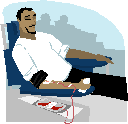
|
|
|
Cultural Link |

Topics of Interest In this IssueAlcohol Awareness Month STD Awareness Month Public Health Week 2—8
National Allied Health Week, 7—13
· · · · · · · National Marrow Awareness Month · National Allied Health Week, 7—13
|
|
APRIL QUESTION A recent study to determine patients’ feelings about healthcare providers collecting information about their race and ethnicity found which rationale most acceptable to patients? A. Monitor and assure quality of care for the individual patient B. Abide by government recommendations C. Ensure appropriate hiring and training of medical personnel D. Monitor and assure quality of care for all patients
Email your response to nwosu@etsu.edu by 4:30 pm on April 14. Answers are always in a link found in the current month’s newsletter. A prize will be awarded to one winner, selected at random among those who submit the correct answer.
Answer to the March Question: What percentage of health plans do not collect information on race and ethnicity? The answer is D. about 50% of insurance plans do not collect information on race and ethnicity. Highlights and implications from the findings of the National Healthcare Quality Report and Disparities Report
Did You Know?¨ For some immigrant groups, the diagnosis of Tuberculosis carries a severe social stigma that can affect treatment compliance. Reasons for the stigma may be related to the closeness of their communities and the fact that in their countries of origin, historically, TB was not a curable disease.
¨ Asthma is a significant health and economic concern for some minority populations. Among Hispanics, Puerto Ricans have the highest age adjusted mortality for this disease. African Americans are 3 to 4 times more likely than whites to be hospitalized for asthma and 4 to 6 times more likely to die from the disease. Asthma is the leading cause of school absenteeism due to chronic illness, with asthmatic children loosing an estimated 10 million excess school days annually. The economic impact for the working parents of asthmatic children is estimated at $1 billion annually in lost productivity.
|

Health Links on Diversity |
|
Article of the Month Burke W. Contributions of Public Health to Genetics Education for Health Care Professionals. Health Education and Behavior 2005; 32 (5): 668—675.Summary: Genetics education is becoming more important for health professionals because of rapidly increasing knowledge of the role of genetics in health. While the health professions schools will be primarily responsible this training, public health will contribute because of its stake in having a rigorous evidence standard for the introduction of new genetic tests. The CDC and academic public health departments already provide online resources for clinicians and educators as the GeneTests-GeneClinics Web site that provides information about the use of genetic testing in diagnosis and disease management. State health departments could provide resources via telephone and telemedicine to assist primary care professionals in medically underserved areas. Public health may also provide leadership in sponsoring forums on controversial issues raised by new genomic tests and technologies, for example, the role of genetics in racial and ethnic health disparities and “race based” medicine.
assessed annually for three years. The research took an ecological approach simultaneously studying multiple individual, family, and community risk and protective factors focused on occurrence of two types of abuse: severe physical assault and assault of child self-esteem.
|
|
The listing below represents just a few of the resources available to promote knowledge, awareness and discussions on diversity in health care among ETSU students, faculty and staff.
|
TOPIC TITLE & LOCATION |
|
For more information or assistance contact Elaine Evans, Reference Assistant, COM Library,
For more information or assistance contact Elaine Evans, Reference Assistant, COM Library, evanse@etsu.edu. |
Other Observances in April |
|
April 2006 |





|
Minority Health Month
|
Common Health Problems in Selected Minority, Ethnic and Cultural Groups— This site presents summary information about selected groups along with the warning to pay attention to the individual in order to avoid stereotyping.
Clinical Pearls of Cross Cultural Care– The EthnoMed site contains information about cultural beliefs and medical issues for several ethnic groups which comprise recent immigrants to the US, many of whom are refugees from war impacted areas of the world.
Patients’ Attitudes toward Health Care Providers Collecting Information about their Race and Ethnicity—What is the best way to ask?
Lead in the Blood of Children— Overall, the percentage of children aged 1—5 with elevated blood lead levels has dropped dramatically since 1976—80, but African American children were more likely than others to have elevated blood lead levels
|
|
Alcohol Awareness
|
Alcohol Consumption Among Racial/Ethnic Minorities: Theory and Research This summary of the literature uncovers some myths and stereotypes. It describes some of the newer research which recognizes the heterogeneity within ethnic groups, and propose multi-factor explanations of drinking behavior. Minority Women and Alcohol Use, Winter 2002. This article considers both the cultural and biological influences on alcohol use by women from several racial and ethnic minority groups.
|
|
|
April is STD Awareness Month—What can you do to raise awareness? Tennessee Statistics for STDs—2003 State and regional data. The Tuskegee Study: Hard Lessons Learned: This CDC site briefly summarizes the timeline for this infamous study and the aftermath.
|
|
Public Health
|
Valuing people: health visiting and people with learning disabilities - Article describes use of health visitors to engage people with learning disabilities in a collaborative program encouraging them to make healthy lifestyle choices. Disability and Health in 2005: Promoting Health and Well-Being of People with Disabilities—How can we promote the healthy behaviors of people with disabilities?
|
|
World Health Day 7
Passover (Jewish commemoration of the Exodus from Egypt) 13—20
Palm Sunday, Good Friday, Easter Sunday (Christian) 9, 14, 16
Songkran (Buddist New Year) 14
Minority Cancer Awareness Week 16—22
Earth Day 22
Infants Immunization Week 23—29
|
Arbor Day 28
Holocaust Memorial Day 25
Take Your Daughter/Son to Work Day 27
Gathering of Nations Pow Wow
Cancer Control Month
Child Abuse Prevention Month
Counseling Awareness Month
Occupational Therapy Month
|
|
Arts, Cultural, and Health Awareness Events |
||
|
4/3—6 |
Best Western Conference Center |
|
|
Well-a-Palooza |
4/5 |
Pedestrian Walkway, Main Campus |
|
4/11 |
Culp, Meeting Room 3 |
|
|
The Summit: Celebrating Distinguished Student Leaders & Programs |
4/11 |
Millennium Centre |
|
4/11 |
Culp Auditorium |
|
|
4/12 |
Culp Center, Amphitheatre & Cave Patio |
|
|
Women’s Resource Center Book Review: Things Unspoken, Anitra Sheen |
4/19 |
WRC, Panhellenic Hall, Basement, Suite 2 |
|
A Doll’s House by Henry Ibsen |
4/20—23 |
VA Memorial Theater; Student rate |
|
4/28 |
Millennium Centre |
|
|
ETSU Arts, Cultural, and Health Awareness Events |
||
|
4/3—6 |
Best Western Conference Center |
|
|
Well-a-Palooza |
4/5 |
Pedestrian Walkway, Main Campus |
|
4/11 |
Culp, Meeting Room 3 |
|
|
The Summit: Celebrating Distinguished Student Leaders & Programs |
4/11 |
Millennium Centre |
|
4/11 |
Culp Auditorium |
|
|
4/12 |
Culp Center, Amphitheatre & Cave Patio |
|
|
Women’s Resource Center Book Review: Things Unspoken, Anitra Sheen |
4/19 |
WRC, Panhellenic Hall, Basement, Suite 2 |
|
A Doll’s House by Henry Ibsen |
4/20—23 |
VA Memorial Theater; Student rate |
|
4/28 |
Millennium Centre |
|
|
|